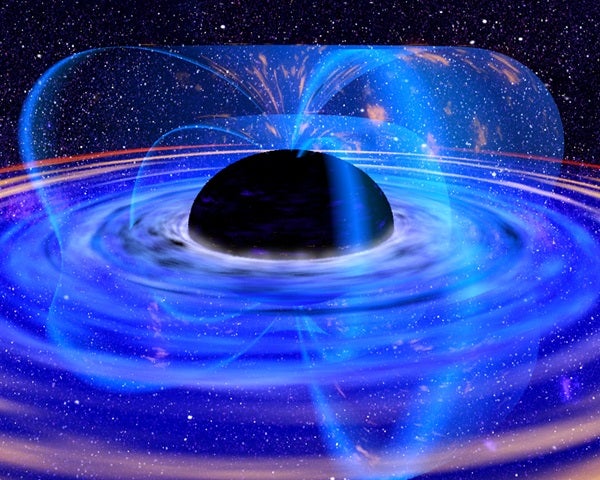The measurements were taken by a team of astronomers from the University of Florida (UF) with the Canarias InfraRed Camera Experiment (CIRCE) on the Gran Telescopio Canarias (GTC), a 10.4-meter telescope in the Canary Islands and the current record-holder as the world’s largest single-aperture telescope. Using CIRCE, an infrared camera built by UF for the massive GTC, they observed jet activity from V404 Cygni, a nine-solar-mass black hole about 8,000 light-years away, during a burst in jet activity in 2015 that lasted just a few weeks. Their results, published in Science earlier this month, are the first precision measurements of a black hole’s magnetic field ever taken — and they show that V404 Cygni has a magnetic field about 400 times weaker than expected.
That poses a challenge for the theories currently used to explain the jets as a result of interactions between the black hole’s magnetic field and matter in its accretion disk — the swirling disk of gas and dust created as matter is trapped by the black hole’s gravity and falls inward. This disk lies outside the event horizon, rendering it visible to astronomers and allowing them to spot the black hole via its light. “Our surprisingly low measurements will force new constraints on theoretical models that previously focused on strong magnetic fields accelerating and directing the jet flows,” said UF professor and study co-author Stephen Eikenberry in a press release. “We weren’t expecting this, so it changes much of what we thought we knew.”
But this challenge is a welcome one, as it will finally help astronomers begin to unravel the poorly understood magnetic fields around these exotic objects, even if they turn out too weak to launch jets and other activity. “This discovery puts us one step closer to understanding how the universe works,” added lead author Yigit Dalilar.
A closer look
V404 Cygni is classified as a microquasar, or a stellar-mass black hole that behaves similarly to the bright, monster-sized supermassive black holes that reside in the centers of galaxies. Quasars are the brightest objects in the universe, and they arise from the radiation emitted by an accretion disk surrounding a black hole weighing millions of times the mass of our Sun. These objects launch jets many light-years long, but because they are so big, changes in the jets and disk often occur over periods of months or more.
V404 Cygni’s recent flare was observed in multiple wavelengths, including X-rays. This animation depicts the 2015 outburst.
NASA/Goddard Space Flight Center/Conceptual Image Lab
Microquasars are scaled-down versions of quasars — and that scaling applies to timescales as well. While microquasars are dimmer and have much smaller disks and jets, they also show changes over much shorter periods of time: weeks, days, or even hours. Studying Milky Way microquasars like V404 Cyngi allows astronomers to make observations they can then extrapolate to the much larger, more distant quasars.
The V404 Cygni system, located in the constellation Cygnus, has undergone bursts of activity before. Previous outbursts occurred in 1956 and possibly 1979, as well as 1989 — its last outburst until 2015. V404 Cygni’s disk comes from its nearby K-giant companion star; the black hole and its 0.7-solar-mass companion orbit each other closely, with a period of just under 6.5 days.
In addition to capturing the black hole’s 2015 activity in infrared light, astronomers also watched V404 Cygni in X-ray, optical, and radio wavelengths. Studying its outbursts in so many wavelengths will further help astronomers to piece together a complete picture of this black hole, and ultimately reveal the secrets of its big brothers inside quasars as well.










